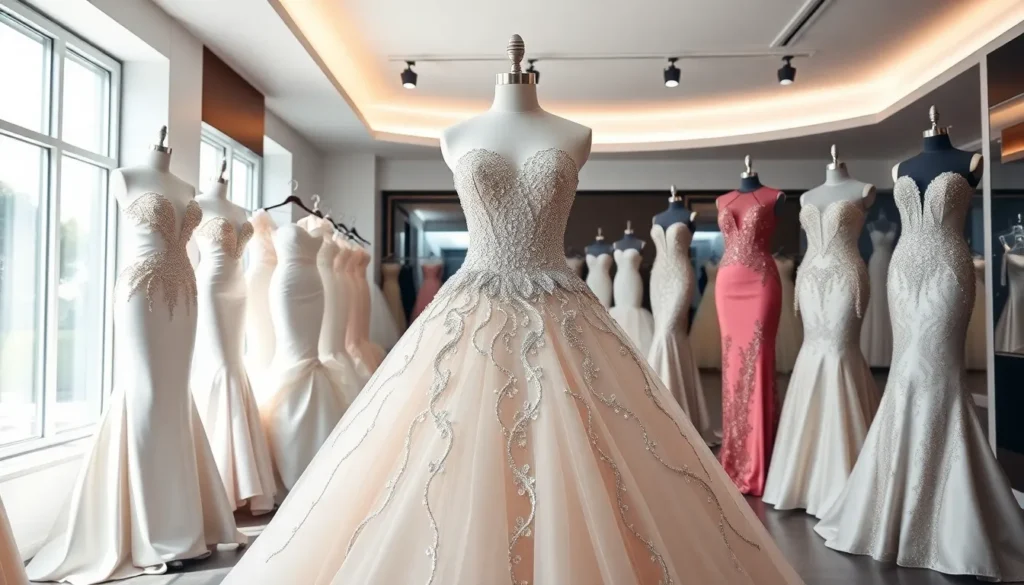Table of Contents
ToggleWhen you think of beauty pageants, images of dazzling gowns and radiant contestants likely come to mind, right? Those stunning dresses aren’t just about looking good: they tell a story, reflect personal style, and eventually signify months of preparation and dedication. Whether you’re a contestant gearing up for your moment in the spotlight or simply a fan of the pageantry world seeking to understand its flair, you’re in for a colorful treat. Buckle up as we jump into the glamorous universe of beauty pageant dresses.
The Evolution of Beauty Pageant Dresses

Over the decades, beauty pageant dresses have undergone a dramatic transformation. In the early 1900s, the focus was primarily on modesty and simplicity, with competitors donning dresses that highlighted elegance without excessive flair. But, as societal norms shifted, so too did pageant attire. The swinging ’60s introduced a splash of color and boldness, while the ’80s took a more extravagant turn with ruffles and sequins galore.
Today, beauty pageant dresses are a canvas for self-expression, blending tradition with individual creativity. Designers like Sherri Hill and Mac Duggal have become household names within the realm, known for their elaborate designs that accentuate every curve and create a striking silhouette on stage. This evolution is not just about changing trends: it’s a reflection of culture, empowerment, and the relentless pursuit of beauty in diverse forms.
Key Features of Beauty Pageant Dresses
What makes beauty pageant dresses truly special? It’s all in the details. Here are some key features that often define these magnificent gowns:
- Fit and Silhouette: Each dress is tailored to highlight the contestant’s physique. A well-fitted gown can transform a contestant’s appearance dramatically, providing her with confidence and poise.
- Fabric Choices: From luxurious silk to shimmering satin, quality fabric can elevate a dress from ordinary to extraordinary. The choice of material also affects how the garment flows and moves during the competition.
- Embroidery and Embellishments: Intricate beadwork, sequins, and appliques are common embellishments that catch the spotlight during performances. These accents add layers of depth and character, making each dress unique.
- Train and Hemline Variations: The train’s length can either add drama or enhance elegance. From sweeping trains that flow behind to the chic appearance of a shorter hemline, each choice carries its own flair.
Popular Styles of Beauty Pageant Dresses
There’s no shortage of styles when it comes to beauty pageant dresses. Here are some of the most popular designs currently making waves:
- Ball Gowns: For the fairytale moment, ball gowns with voluminous skirts and strapless bodices are classic choices. They exude elegance and give contestants a princess-like aura.
- Mermaid Dresses: These gowns are designed to hug the body and flare out at the knees, showcasing curves in all the right places. They’re both sultry and sophisticated.
- A-line Gowns: Versatile and flattering, A-line dresses can suit various body shapes. They feature a fitted bodice and flow gently to the ground, making them an excellent choice for many contestants.
- Sheath Dresses: For those looking to make a bold statement, sheath dresses offer a sleek, streamlined silhouette. They’re often adorned with striking details that set contestants apart from the crowd.
Choosing the Right Dress for Your Pageant
Selecting the perfect dress for a pageant can be overwhelming, given the myriad options available. Here are some key considerations:
- Identify Your Body Type: Understanding your body type is crucial. What works for one may not work for another, so embrace your shape and choose a silhouette that flatters it.
- Consider the Pageant Theme: Different pageants may prioritize different styles. Research past events to gauge what works best and fit within the expected aesthetic.
- Budgeting: Dresses can range from affordable options to extravagant designs. Set a budget that includes not just the dress itself but also alterations, shoes, and accessories.
- Seek Professional Advice: Sometimes, enlisting a stylist or consultant can be a game changer. Professionals can offer insights on trends and suitable designs tailored to your needs.
Tips for Customizing Your Pageant Dress
Customization is the icing on the cake when it comes to beauty pageant dresses. Personalizing a gown ensures it reflects your individual style while still meeting competition standards. Here are tips on how to achieve that:
- Choose the Right Colors: Finding hues that complement your skin tone can make a world of difference. Earthy tones, vibrant shades, or classic black can all work depending on personal preference.
- Incorporate Unique Accessories: Adding personalized accessories, like a custom tiara or unique jewelry, allows contestants to express themselves further.
- Tailoring: Ensure the dress fits like a glove. Good tailoring can enhance a dress’s appearance, making it look even more stunning on stage.
- Experiment with Details: Don’t shy away from making bold choices. Whether it’s a unique back detail or asymmetric cuts, these nuanced touches can set your dress apart.
Caring for and Maintaining Pageant Dresses
Once the perfect dress is in hand, the next step is ensuring it remains in pristine condition. Proper care is essential:
- Storage: Always hang your gown in a cool, dry place, ideally in a breathable garment bag. Keep it away from direct sunlight to avoid discoloration.
- Dry Cleaning: After a pageant, take the dress to a professional dry cleaner specializing in formal wear. Avoid washing machines which can damage delicate fabrics.
- Inspect Regularly: Frequent inspections help to catch any loose beads or seams before they escalate into larger issues. Catching small problems early saves time and money later on.
- Repairs: Minor repairs like sewing loose beads or restitching hems should be handled promptly to prevent more extensive damage down the line.







